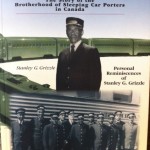You can bet that I will never mispronounce (retired) Judge Stanley Grizzle‘s name again. For the record, it’s “Grizz – ZELL.” But mispronounce it I did when calling to set up an interview with the former judge. Luckily, he has a sense of humour and I was clearly not the first to mess up his name. We went on to have a fascinating conversation, and the result is this profile.
My May newsletter talks about interviewing techniques, and here’s how those tips relate to this piece:
• Be prepared. The Canadian Press Stylebook says, “Know your subject,” which helps you ask intelligent questions. You also don’t waste time asking questions that are answered elsewhere. That might mean collecting executive summaries, PowerPoint slides or other background or doing online research before your conversation. In this case, the client provided some background, and I read the judge’s (short) book, My Name’s Not George: The Story of the Brotherhood of Sleeping Car Porters: Personal Reminiscences of Stanley G. Grizzle.
• Put the interviewee at ease. I usually set up interviews by email, but in this case, I started with the telephone. I introduced myself, explained what I was looking for and where the piece would be published, and assured the judge he would have a chance to review the article before it went anywhere. We agreed that I would meet him after a citizenship court session, which I could also attend. This is where I saw firsthand his polished shoes, which is how I opened the article, and that he could still talk to anyone, which is how I ended it.
• Set expectations. Most corporate and magazine work is done to a word count. I mentioned that our conversation might cover a lot of ground that would useful for context but it wouldn’t all make it into the final article. I also gave an expected time I hoped to finish a draft, and checked that he would not be away.
• Have questions ready but make the interview a conversation. The CP Stylebook calls this letting the interview “take on a life of its own.” The guide also suggests you “listen for answers you didn’t expect and be prepared to follow up.” Having read the book, I had noted some areas where I wanted an explanation or his own words to add personality to the story, but we covered a lot of other ground.
• Find the people involved in the story. Since this was a profile related to train travel, I needed detail about just this one person. What did his job involve? What was the hard parts? What was interesting or enjoyable? What does he think about travel?
• Ask the meaning of any acronyms and abbreviations; ideally, you aren’t going to use acronyms anyway for the sake of a clear, readable story. In the corporate world, this is pretty common, but it did not apply here.
• Make sure you understand anything complex or confusing. Don’t be embarrassed to ask “dumb” questions, because you’re going to have to explain it to the reader. Ask for examples, or a simple way to describe the topic. Get a sense of scale. Put numbers in context. For this profile, I asked Judge Grizzle to explain some aspects of his job and clarify how judges were chosen.
• Make your final question a good one. Often the best comments and quotes come at the end of a conversation. I almost always ask, “Is there anything we haven’t talked about that should be included in this article?” or “If the reader takes away just one thing from this article, what do you want it to be?”
Do you have any other tips for getting a good interview?
Related articles:
How to get a meaty quote
How to turn your notes into polished gold


Excellent tips. I also read the finished piece. Nice job!
Thanks, Donna! Much appreciated.